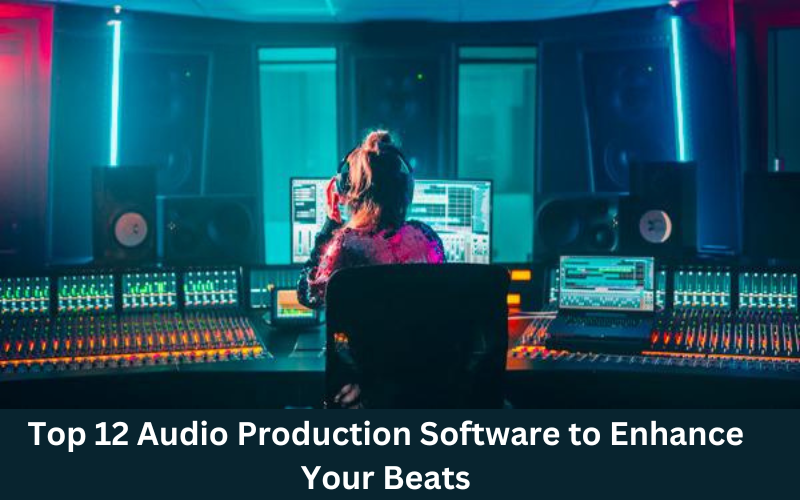Welcome to the world of audio engineering! It’s where your creative potential is unlimited and tools are your friends that achieve everything. Visualize making sound spaces, creatively arranging melodies, & sonically mastering pieces using digital music production programs.
Today, we will be venturing into the universe of the Top 12 Audio Production Software for audio engineers and producers everywhere. This is where every phone stands out from the crowd; each providing a range of interesting characteristics, functions, and design features. No matter you’re a pro or the new one, you will be provided with equal chances.
The software devices fit into distinct categories providing a multitude of solutions depending on your music, podcast, and movie needs and a wide range of tools to turbocharge your audio entertainment. Towards the top of the class with commitment, wisdom, and joy. Come to my place & choose the one that will work for you! Let’s get creative!
12 Best Software for Audio Production: Enjoy High-Quality Music Now!!
Let’s delve deeper into the Top 12 Audio Production Software:
1. Ableton Live:

Image credit – PCmag
- Description: The Ableton Live is a multiple purpose digital audio workstation (DAW) which appeals to dance music producers, DJs, and youn room artists. It offers a distinctive two-mode view, as session view is handy for live performances and jamming while arrangement view is great for structured composing.
- Key Features: Makes music production enhancing MIDI & audio recording function as well as real-time time-stretching & warping, extensive built-in instruments & effects. Customizable time signature and groove created with the help of in-built device tracker. And hands-on plate, Ability to use Max for Live to create custom MIDI devices.
- Pros: Feature: Intuitive user interface, good for real-time performance, with a wide range of built-in instruments. And effects, and seamless corporate -resistance with hardware controllers.
- Cons: Aggregate song parts could be a problem for the users, besides it can be hard to find a standardised workflow like the one of other DAWs.
2. Pro Tools:

Image credit – Avid Technology
- Description: Pro Tools is an industry-standard DAW widely used in professional audio recording, editing, & mixing, particularly in music, film, & television post-production.
- Key Features: Industry-standard audio editing & mixing tools, advanced automation & plugin support, extensive session management features, comprehensive collaboration tools.
- Pros: Pro-audio quality & editing tools are also available, plus some features to manage the whole sessions become more powerful.
- Cons: Costlier product, beginner users face initial challenges, superior function if applicable,Full functionality on complementing hardware.
3. Logic Pro X:

Image credit – Apple
- Description: Logic Pro X is a macOS exclusive DAW resulting in its advanced functions, being easy to use, & having many virtual instruments.
- Key Features: Massive variety of virtual instruments & effects, Flexible Time & Pitch for precise audios. Drummer & Smart Controls, one-touch music production feature, & Logic Remote for your smart device control.
- Pros: Easy to navigate the flow work, a multitude of virtual instruments & special effects with easy integration with macOS & other Apple’s devices.
- Cons: There is macOS version availability, one would have to give it a second thought for older hardware.
4. FL Studio (Fruity Loops ):

Image credit – Sound on Sound
- Description: FL Studio a.k.a. Fruity Loops, is a DAW of electronic music producers’ choice. Enabling artists to create high-quality tracks with its intuitive interface & variety of both internal & externally acquired plugins.
- Key Features: Sequencer on the steps for creation of patterned composition of music, Piano Roll for MIDI editing. Diverse instruments & effects implemented, flexible routing & automation are included.
- Pros: User-friendly interface, Plugins that cover a wide range of needs, life-time free updates, & reasonable pricing options.
- Cons: Native to PC (with macOS beta), like other DAWs, this may be a sin for some users to be less convenient.
5. Cubase:

Image credit – Steinberg
- Description: Cubase is a powerful multitrack DAW standout & the favourite among composers. It comes with MIDI functionality, multitrack audio recording, & a large number of virtual instruments & effects available.
- Key Features: Complex MIDI editing systems, VariAudio for the correction of pitch & manipulation of melodies. MixConsole, for great mixing, & VST Expression for articulation control.
- Pros: As for the MIDI editing capabilities it is considered a complex one that contains lots of virtual instruments & effectives. It is very easy to change the MIDI routes & mix it as we want.
- Cons: Initially, it is somewhat difficult to learn it from the beginning & it is expensive compared to other digital audio workstations.
6. Studio One:

Image credit – Presonus Shop
- Description: Studio one is an example of a DAW that an end-user can enjoy for recording, editing, mixing. And mastering audio with its enhanced functionality.
- Key Features: Modern sound tools like drag-&-drop interface, Arranger Track for non-linear composition. Scratch Pads for testing various arrangements of work, a comprehensive collection of virtual instruments & effects.
- Pros: Such functions as an easy-to-use workflow, heavy-duty tools for editing & mixing. Hassle-free integration with PreSonus hardware & increased speed of new feature additions.
- Cons: While the interface is clean & simple, one will find out some features are not as advanced as that of other DAWs.
7. Reason:

Image credit – Sudeep Audio
- Description: It is well-known that reasoning is God’s gift when it comes to his rack-based interfaces. Bringing together his library of virtual instruments, plug-ins, & routing arrays for thousands of sound design possibilities.
- Key Features: A simultaneous installation interface that offers unlimited access to virtual instruments & effects. As powerful as the routing & routing ability with the intuitive patching system.
- Pros: Custom designed for experimentation are the special workflow options, plus high-quality built-in instruments & effects. This delivers a high level of quality for electronic music & sound design productions.
- Cons: Lack of universal third-party plugin support & anti-design concept may be drawbacks that some users would encounter.
8. Native Instruments Komplete:

Image credit – Native Instruments
- Description: In contrast to other standalone DAWs, Komplete is a suite of various high-quality instruments, effects. And samplers that could be used within different DAWs.
- Key Features: The Komplete Kontrol has a wide variety of virtual instruments, effects & sounds, including devices for synthesis, sampling, & orchestral instruments. It also has Komplete Kontrol for quick & unified instrument browsing & control.
- Pros: High-quality samples with easy mixing patterns; compatibility with popular DAWs, huge number of genres covered, including the mainstream ones.
- Cons: DAW is required, but in addition to that you may have to enable more storage space to cover the big universal library.
9. Bitwig Studio:

Image credit – Bitwig
- Description: According to Bitwig, the Synth Modular Section is completely unlike any modular environment for sound design that you have ever used before. While with its Major Feature which is excellent integration with your favourite external hardware effects like your hardware synthesisers, analog drum machines & effects pedals. This particular interface offers a solution more suited for the contemporary electronic music producers & performers of today.
- Key Features: Humanised features: modular environment structure, MIDI & audio editors of virtually unlimited capabilities. Device nesting & layering with a hurricane power, top-notch integration with other hardware controllers.
- Pros: Imaginative functional with modular area, strong MIDI & audio editing programs, adaptable route ability & modulation plan.
- Cons: Difficult to learn if the new user base is small in comparison to other DAWs, & some tools may need a learning curve.
10. Reaper:

Image credit – Reaper
- Description: Reaper is widely appreciated for its pocket-friendly price & easy-to-transport footprint among the sound professionals. Offering a wide range of features that could be used for recording & mixing.
- Key Features: The user interface is customizable, plug-in support is wide. The program works faster even on poor computers, all of that features are available to users. Routing & automation right through can be done by them.
- Pros: Considerable savings, moving to a pay-as-you-use model with plenty of setup options. Ultra-fast loading times, & abundant options for tailoring the web application to their needs.
- Cons: Less intuitive for beginners, some advanced settings might need additional setup or configuration. The way it wouldn’t be the case with a simpler feature that is more intuitive.
11. Audacity:

Image credit – Wikipedia
- Description: Audacity is a good & free product that can help to make simple recording, editing, & basic mixing. It is open source which means that you. As a user, you can have access to its source code to make any improvements as per your liking. It has multiple versions that are compatible with so many platforms, including Windows, macOS, & Linux.
- Key Features: Recording & editing of multiple tracks, basic effects, different audio format support. As well as the plugin support to use additional features in the construction of this primary software.
- Pros: The feature of no cost, all platforms support it. This is very light & easy to install which is a great option for newbies in audio editing tasks.
- Cons: In terms of features it is unable to cover the same track with full DAW. Limited end use for advanced music production tasks & interfaces can be old-fashioned.
12. Adobe Audition:

Image credit – Adobe
- Description: Adobe Audition is part of the Adobe Creative Cloud [pack] & it comes with advanced audio editing, restoration, & mixing [capabilities,]. Thus chosen by most podcasters & audio post-production experts.
- Key Features: Multitrack recording & editing, spectral editing for super accurate sound restoration, a comprehensive audio effects collection. Native support for other Adobe Cloud applications.
- Pros: Such features as advanced pro audio editing, a bulk of restoration tools, user-friendly interface. And its integration with the Adobe Creative Cloud.
- Cons: Adobe Audition CC user needs an Adobe Creative Cloud membership, may utilise more functions than required for straightforward audio editing. And it is not as DAW-focussed as other DAWs.
Among the software choices, these software packages offer you pretty much the list of price points & features. As well as cater to the level of skill & needs of target users. Your pick should be based on the particular requirements you are faced with. Including but not limited to budget & workflow. Moreover, evaluate carefully the options that best suit you. Be sure there is nothing confusing at this point. Save your data before you do any experiments. If you need more lab equipment, try to secure their assistance.
Which Software is Most Recommended for Audio Production?
It is highly likely that the “most recommended” audio production software differs from person to person. Based on factors like personal workflow requirements & industry standards. However, I can provide recommendations based on common scenarios:
1. For Professional Studios & Post-Production Work: Being Pro Tools the de facto choice of many professional studios today means that it is extremely dominant among this group. Particularly in the music production industry as well as film & television post-production. Its comprehensive package, stability, & broad usage make it a winner for team work, the advanced environments projects, & the like.
2. Electronic Music Production & Live Performance: Live within Ableton Live is highly recommended thanks to a unique session view, real-time operating with performance, & constant library of built-in instruments & effects. It is especially widespread among the electronic music producers & DJs & such performers as punk-rockers & 3d performance users for its versatility & live performance features.
3. Mac Users & Composer/Arrangers: Logic Pro X, as well, is a great tool. But it is mostly suitable for those who work on macOS. Its straightforward & rich interface. Huge collection of virtual instruments & effects. And efforts to synchronise with other Apple ecosystems can be the main factors of choice for composers, arrangers. Musicians trying to be a full-fledged sound studio.
4. Budget-Friendly & Versatile Option: What makes FL Studio (Fruity Loops) a better choice is the fact that it has the right balance of affordability, versatility, & user-friendliness. However, it finds its way in both the newcomers & pros. Especially in electronic music creation, as well as in Hip Hop & other similar projects.
The “best” one, however, is that it depends on your particular needs. The level of skill, & the preferred workflow that is used. The demo is good advice. You should handle different software trials to know what software suits well with your demand before making a final decision.
Frequently Asked Questions
Here are some frequently asked questions about the best Audio Production Software:
1. In what specific ways has Pro Tools earned its role as an audio production tool & industry leader?
– Answer: “Pro Tools is now widely known beyond its original status as a professional audio software for recording, editing & mixing. Particularly in music production & post-production for movies & TV.”
2. What makes Ableton Live software differ from others?
– Answer: Ableton Live becomes especially popular for its innovative session view which allows live performances, unlimited MIDI capabilities. And an extensive library of instruments & effects which makes it a number 1 choice among electronic music producers & live performers.
3. Why do Mac users most likely prefer Logic Pro?
– Answer: However, Logic Pro X is exclusively for Apple’s macOS & it provides effective communication with different Apple gadgets. It saves time & lets the user get the best out of his or her Mac. Its user interface that is easy to use, the variety of instruments that open source software that is free. And Mac OS that is compatible with this makes it the best choice for composers, arrangers, & musicians.
4. In which genre or niche, FL studio is mostly used?
– Answer: FL Studio, also known as Fruity Loops, has become a widely used platform for electronic music, beat-making & hip-hop production. This is because of the user-friendly interface, automated pattern programming & a wealth of built-in effects.
5. Which aspects, in your opinion, serve as “the most recommended” goodness offered for audio creation?
– Answer: Tool selection is based on individual competences, workflow experience, & conventional approaches in a given field. Factors likens to stableness, feature set, user-friendly, compatibility. And also genre considerations determine my audio production software recommendation.
Conclusion
As we draw the curtains on our exploration of the Top Audio Production Software, one thing becomes abundantly clear. On one side where artists come to life the sonic art industry lies as diverse & vibrant as the artists that bring it to life. From the long-standing industry standard setting software like Pro Tools & Logic Pro X up to the unique & innovative offerings from Ableton Live & FL Studio.
Every software features whatever it specialises in. Whether you create symphonies, compose beats, edit podcasts or score movies. You can use any tool you like, the spectrum of the music production software is wide.
Consequently, as you embark on your creative process, laptop & headphones. You can always count on these powerful tools to do the work for you & imagine limitless possibilities.
Music makes the world go round. The more the complexities of life. It plays in your dreams & connects all living things all the way up to what it means to be human. Happy producing!








